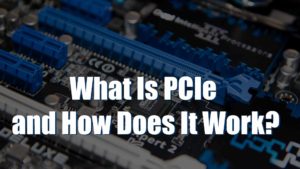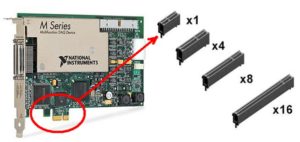PCIe, short for Peripheral Component Interconnect Express or just PCI Express, is something that every PC enthusiast have heard of. Similarly, It’s an interface that has long been used by graphics cards and in recent years by solid state drives. But how does it work, and what is the difference between versions?

A new protocol called PCI Express (PCIe) eliminates a lot of these shortcomings, provides more bandwidth and is compatible with existing operating systems.
PC: Build a Cheap Gaming Computer in 5 Steps
PCIe Past, Present & Future
The PCI Express interface was created to replace older standards such as PCI, PCI-X and AGP. The first official specifications were decided on by the PCI Special Interest Group (PCI-SIG) organization in 2003. But This organization has since continued to improve the standard through the years.
-
PCI Express 1.0a
PCI Express 1.0a was the first version of the interface and offered transfer speeds of up to 2.5 GT/s, or gigatransfers per second. Something that set PCIe apart from the beginning was that the interface uses serial transfer technology while older standards were based on parallel transfers. In 2005, PCI Express version 1.1 was introduced. This version came with updated specifications and a number of improvements, but the data transfer rate was left unchanged.
-
PCIe Version 2.0
Version 2.0 of PCIe announced in 2007and now the transfer speeds doubled compared to version 1.0 to 5 GT/s. Each lane could now handle up to 500 megabytes of data per second, meaning that a PCIe 2.0 connection using 16 lanes offers an 8 gigabytes per second (GB/s) transfer rate. In addition to the higher bandwidth, PCIe 2.0 also came with some software improvements and an improved transfer protocol.
-
PCI Express 3.0
PCI Express 3.0 is still used extensively today. The specifications for PCIe 3.0 were completed in 2010 and brought the data rate to 8 GT/s per lane. signal and data integrity introduced better over the previous generation.
-
PCIe 4.0
PCIe 4.0 was announced already in 2011 but was not brought to consumers until AMD launched the X570 motherboard chipset and Ryzen 3000 processors in 2019. Bandwidth is once again doubled to 16 GT/s per lane. As of 2020, PCIe 4.0 is supported by some AMD graphics cards, but adds only minor performance improvements as far as GPUs are concerned. Solid state storage devices using the M.2 socket are considerably better at utilizing the additional bandwidth.
| Version | Bandwidth | Gigatransfer | Frequency |
| PCIe 1.0 | 8 GB/s | 2.5 GT/s | 2.5 GHz |
| PCIe 2.0 | 16 GB/s | 5 GT/s | 5 GHz |
| PCIe 3.0 | 32 GB/s | 8 GT/s | 8 GHz |
| PCIe 4.0 | 64 GB/s | 16 GT/s | 16 GHz |
| PCIe 5.0 | 128 GB/s | 32 GT/s | 32 GHz |
| PCIe 6.0 | 256 GB/s | 64 GT/s | 32 GHz |
PCIe 3.0 continues to exist in parallel with PCIe 4.0 and this situation is unlikely to change in the near future. However, PCI-SIG has already announced the specifications of both PCI Express 5.0 and 6.0, both of which double the transfer rates of previous versions to 32 GT/s and 64 GT/s, respectively.
What does PCIe x1, x4, x8 and x16 mean?
Other than the different PCI Express versions, there are four different types of connectors used on consumer motherboards. These are called, for example, PCI Express 3.0 x1, x4, x8 and x16. These names indicate how many lanes are used by each type of connection. An x1 connector is significantly smaller in size than the large x16 connectors used by graphics cards. But the amount of bandwidth offered is also directly proportional to the number of lanes.

PCIe x8 and x4 however may look like an x16 card, so any full-size connection could technically be used as an x16, x8 or x4 connection. Therefore motherboard depend on how its configured. By adding additional full-size and full-speed slots, motherboard manufacturers may, for example, enable a system with multiple graphics cards, i.e. SLI or CrossFire.
The future for PCI Express
PCI Express has been around for almost two decades and is an established industry standard. As mentioned, the next generations of the interface have already been detailed, but for now there is no hardware on the market to support PCIe Gen5 (and no Gen6 either, obviously). PCI are making their way day by day, We can expect more advanced versions in the graphic card segments.
It’s always possible that a new universal interface emerges and becomes a new standard. However, an increasing amount of product types adapted for PCIe, such as fast SSDs, have arrived only recently. Similarly, at this point, there is no indication that the current situation will change, so PCIe will likely be with us for a long time.
